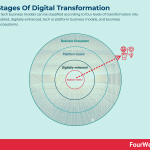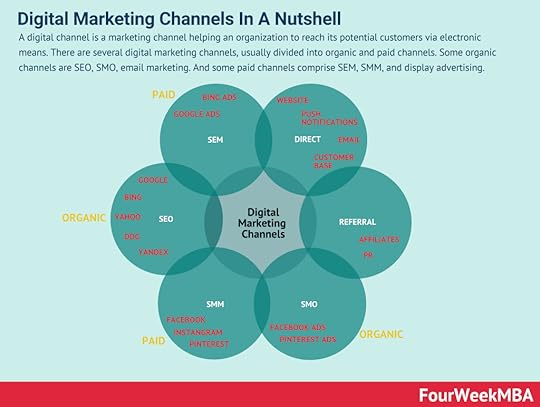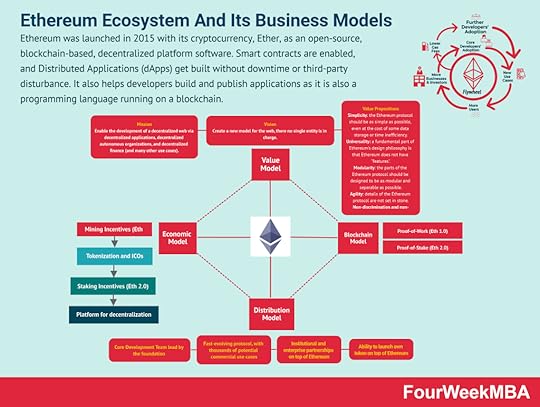The Four Stages Of Digital Transformation

Digital and tech business models can be classified according to four levels of transformation into digitally-enabled, digitally-enhanced, tech or platform business models, and business platforms/ecosystems.
Toward digital transformationThere are numerous ways to classify tech business models, for the sake of the analysis done on FourWeekMBA, we’ll classify them according to the level to which tech effectively changes/enhances the value proposition for users/customers. Indeed, we initially defined a tech business model, as a business where technology plays a key role, not for its own sake, but for the sake of enhancing the value proposition for the individual user/customer and enabling that value proposition to scale. Therefore, individual enhanced value propositions (the single user/customer is better off) and enhanced collective value propositions (the more users join in the more the service/product becomes valuable – aka Network Effects) become commandments of a viable tech business model.
For the sake of it, let’s see four key types of models:
Level one: tech and digitally-enabledDigital embracing primarily how the product is framed and communicated to the customer/user.
In this specific case, technology plays a key role in communicating/distributing the product, but little in shaping it. Thus, take the example of a company that has simply built a website and communicates its product via that (communication level).
Or a company that has learned how to integrate digital marketing within its own corporate strategy. In that case, this is the most basic way to apply technology to a business model. There is no change in how the value proposition is shaped but rather to how it is communicated or distributed.
Here technology is used to better communicate the product/service.
 A digital channel is a marketing channel, part of a distribution strategy, helping an organization to reach its potential customers via electronic means. There are several digital marketing channels, usually divided into organic and paid channels. Some organic channels are SEO, SMO, email marketing. And some paid channels comprise SEM, SMM, and display advertising.Level two: tech-enhanced
A digital channel is a marketing channel, part of a distribution strategy, helping an organization to reach its potential customers via electronic means. There are several digital marketing channels, usually divided into organic and paid channels. Some organic channels are SEO, SMO, email marketing. And some paid channels comprise SEM, SMM, and display advertising.Level two: tech-enhanced Digital enhances the value proposition, therefore it hits at the core of the company’s business model (Hint: Product And Distribution merge)
In that case, technology does impact the way the product is built and delivered. Take the case of a company that built its e-commerce and distributed its products via that, while at the same time it has learned how to integrate customers’ feedback quickly from the online platform to the way the product is designed.
In that case, technology is helping shape the product/service, thus making it more valuable to potential customers.
 A tech business model is made of four main components: value model (value propositions, mission, vision), technological model (R&D management), distribution model (sales and marketing organizational structure), and financial model (revenue modeling, cost structure, profitability and cash generation/management). Those elements coming together can serve as the basis to build a solid tech business model.Level three: platforms and interactions
A tech business model is made of four main components: value model (value propositions, mission, vision), technological model (R&D management), distribution model (sales and marketing organizational structure), and financial model (revenue modeling, cost structure, profitability and cash generation/management). Those elements coming together can serve as the basis to build a solid tech business model.Level three: platforms and interactionsFrom transactions to interactions, ecosystems, and flywheels
 A platform business model generates value by enabling interactions between people, groups, and users by leveraging network effects. Platform business models usually comprise two sides: supply and demand. Kicking off the interactions between those two sides is one of the crucial elements for a platform business model success.
A platform business model generates value by enabling interactions between people, groups, and users by leveraging network effects. Platform business models usually comprise two sides: supply and demand. Kicking off the interactions between those two sides is one of the crucial elements for a platform business model success.In this specific case, a company has moved to a different level. Rather than just selling its own products/services it has moved to build the platform (both tech and business) that drives the interaction between two (two-sided platform/marketplace/peer-to-peer) or more parties (multi-sided platform/marketplace).
Think of the classic example of how Amazon moved from selling products on its e-commerce platform to becoming a hosting platform for other e-commerce to build its own stores.
 Amazon Marketplace is the world’s biggest online retailer, with sales greater than the eCommerce sales of entire countries. Marketplace Pulse estimates that there are over five million sellers on the Amazon marketplace, with over two million on Amazon.com alone. Amazon had enviable sales of over $232.8 bn in 2018 just from its product sales, with over 50% of sales coming from third-party vendors.
Amazon Marketplace is the world’s biggest online retailer, with sales greater than the eCommerce sales of entire countries. Marketplace Pulse estimates that there are over five million sellers on the Amazon marketplace, with over two million on Amazon.com alone. Amazon had enviable sales of over $232.8 bn in 2018 just from its product sales, with over 50% of sales coming from third-party vendors.Here technology becomes an enhancer of the interactions between parties, distribution, and continuous flow of information. Platform business models are moved by network effects.
 A network effect is a phenomenon in which as more people or users join a platform, the more the value of the service offered by the platform improves for those joining afterward.
A network effect is a phenomenon in which as more people or users join a platform, the more the value of the service offered by the platform improves for those joining afterward.While network effects, help platforms pick up speed and momentum and create a long-term advantage, also negative network effects are to be taken into account.
 In a negative network effect as the network grows in usage or scale, the value of the platform might shrink. In platform business models network effects help the platform become more valuable for the next user joining. In negative network effects (congestion or pollution) reduce the value of the platform for the next user joining. Level four: business ecosystem
In a negative network effect as the network grows in usage or scale, the value of the platform might shrink. In platform business models network effects help the platform become more valuable for the next user joining. In negative network effects (congestion or pollution) reduce the value of the platform for the next user joining. Level four: business ecosystemTechnology is at the center of the value enhancement model. Yet in order for it to succeed a community of developers, entrepreneurs, and doers need to adopt the business platform.

This level combined technology and distribution. Where a company has moved to a point where it focuses on governance design, and the underlying tech platform is built and shaped according to that. A classic example is the App Store, and how this has become a business ecosystem, with multiple stakeholders where governance design has become a key component.
Another example that is emerging strongly as a result of the Blockchain, with protocols like Ethereum that enable smart contracts or a whole set of potential applications.
 A Blockchain Business Model is made of four main components: Value Model (Core Philosophy, Core Value and Value Propositions for the key stakeholders), Blockchain Model (Protocol Rules, Network Shape and Applications Layer/Ecosystem), Distribution Model (the key channels amplifying the protocol and its communities), and the Economic Model (the dynamics through which protocol players make money). Those elements coming together can serve as the basis to build and analyze a solid Blockchain Business Model.
A Blockchain Business Model is made of four main components: Value Model (Core Philosophy, Core Value and Value Propositions for the key stakeholders), Blockchain Model (Protocol Rules, Network Shape and Applications Layer/Ecosystem), Distribution Model (the key channels amplifying the protocol and its communities), and the Economic Model (the dynamics through which protocol players make money). Those elements coming together can serve as the basis to build and analyze a solid Blockchain Business Model. Ethereum was launched in 2015 with its cryptocurrency, Ether, as an open-source, blockchain-based, decentralized platform software. Smart contracts are enabled, and Distributed Applications (dApps) get built without downtime or third-party disturbance. It also helps developers build and publish applications as it is also a programming language running on a blockchain.
Ethereum was launched in 2015 with its cryptocurrency, Ether, as an open-source, blockchain-based, decentralized platform software. Smart contracts are enabled, and Distributed Applications (dApps) get built without downtime or third-party disturbance. It also helps developers build and publish applications as it is also a programming language running on a blockchain.In this case, technology becomes an enhancer of governance design, policies, and stakeholder value.
Read Next: Digital Business Models, Tech Business Models, Blockchain Business Models.
Main Free Guides:
Business ModelsBusiness StrategyBusiness DevelopmentDigital Business ModelsDistribution ChannelsMarketing StrategyPlatform Business ModelsRevenue ModelsTech Business ModelsBlockchain Business Models FrameworkThe post The Four Stages Of Digital Transformation appeared first on FourWeekMBA.



